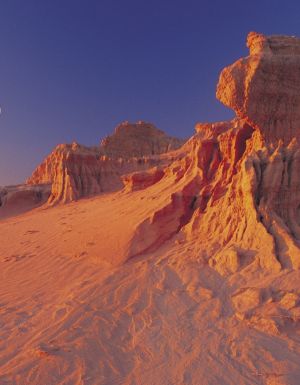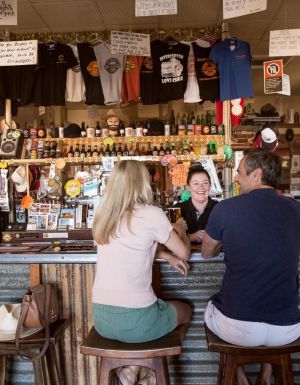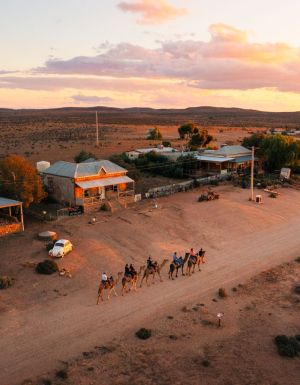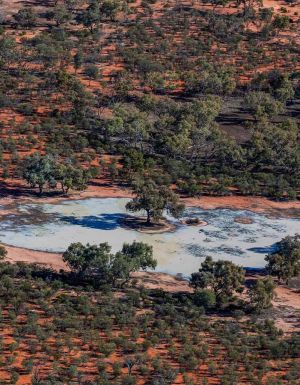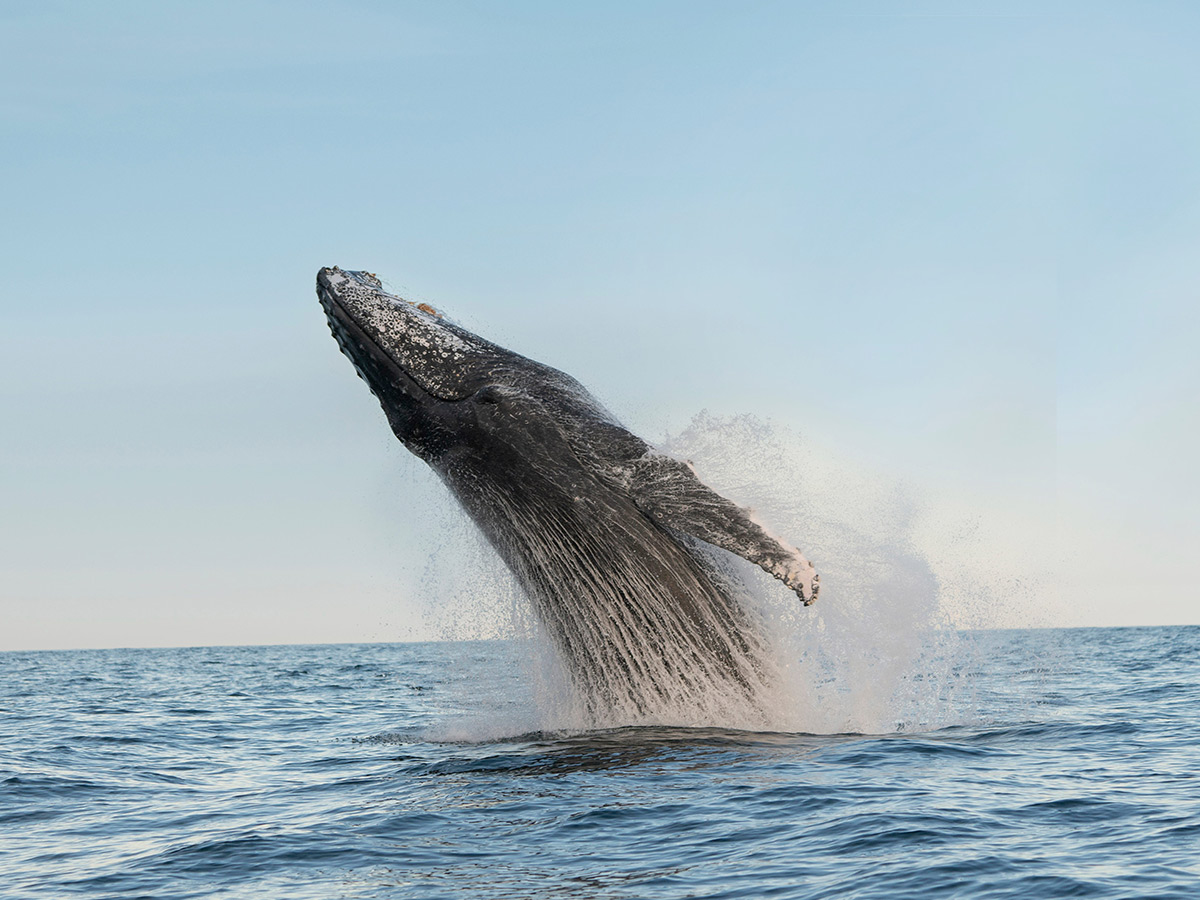The World Heritage-listed site must be seen to be believed.
I’m sure I speak for many of us when I say I’ve always wondered what it would be like to visit the moon. Seeing it in the evening sky always conjures up feelings of whimsy and wonder in me – a mystic, dreamy place just begging to be explored. Unfortunately, also like the majority of us, I can’t afford to just jump in a rocket and zoom on up there.
But what if I told you there’s a place right here on Earth that effortlessly encapsulates this ethereal atmosphere? I didn’t believe it either, until I visited Mungo National Park myself, one of Australia’s most underrated national parks.
Where is Mungo National Park?
Mungo National Park is in Ouback NSW, just over 200 kilometres from the Victorian border town of Mildura or a 10-hour drive from Sydney. The World Heritage-listed site spans 240,000 hectares across the picturesque Riverina Murray region.

For those in the know, Mungo is definitely worth the road trip, with many people travelling to the region purely to witness its lunar-like landscapes. But this ancient, Ancestral place flies relatively under the radar in the grand scheme of things, often overlooked in favour of its Aussie counterparts.
Don’t believe me? Well, while places like Kakadu National Park, Blue Mountains National Park and Daintree National Park see from 200,000 to 6 million visitors a year, just 37,000 people visit Mungo annually. But for what it lacks in numbers, Mungo more than makes up for in beauty, history and cultural significance.
Why visit Mungo National Park?
While the topography of Mungo National Park alone is reason enough to visit, its history is equally as staggering. This is a place where megafauna once roamed, a land that lays claim to the oldest collection of fossilised human footprints ever uncovered – dating back to the Ice Age.

The archaeological discoveries of Mungo Man and Mungo Lady also rewrote history. Discovered in 1968 and 1974 respectively by geologist Jim Bowler, the remains are the oldest known examples of ritual burials in the world, dating back over 40,000 years.
The findings also scientifically proved that Aboriginal culture has existed here since time immemorial. Mungo National Park is on the Traditional Lands of the Paakantji, Ngiyampaa and Mutthi Mutthi people and remains a culturally and spiritually significant site for Traditional Owners. It is symbolic of Australian history, representing the timeless connection First Nations people have with Country.
Must-see sights in Mungo National Park
Mungo can be experienced in a variety of ways, with many visitors opting to explore the national park on their own. I recommend joining at least one of the Indigenous-led guided tours with NSW National Parks and Wildlife Service . It’s a great way to learn about the land’s history and culture, as well as get the most out of your time at Mungo. Here are a few highlights.
Lake Mungo

Lake Mungo is one of 17 arid lake beds within the region. It held a vast amount of water and marine life around 50,000 years ago, but has long since dried and fossilised. The now eroded sand dunes that tower around the park’s circumference continuously reveal evidence of an area once thriving with prehistoric life.
Mungo Woolshed
Built in 1869 using an ingenious drop-log cypress pine construction, this historic woolshed harks back to when Gol Gol pastoral station brought thousands of sheep to the region. The farming activity on this dramatic but delicate land helped archaeologists discover the secrets buried beneath its red-ochre surface.
Walls of China

Arcing around the eastern edge of the lake, the Walls of China is Mungo’s star attraction, where visitors most often describe a lunar-like appearance. Its low curve of sandy hills, or lunette, rises up out of the Earth like pinnacles, sculpted by millennia of sand-soaked winds.
Red Top Lookout
Head to Red Top Lookout in time for sunset for unparalleled views over Mungo. The fading light renders its tapestry of deep ravines and rising hills in all shades of orange, pink and purple, mirroring the magic of the moon.
Mungo Loop Track

Get acquainted with this awe-inspiring desert landscape by driving, or better yet, cycling the 70-kilometre Mungo Loop Track. Cross the ancient lakebed to the Walls of China before tracing its shores, taking in the iconic dunes and mallee trees of Outback NSW.
The Meeting Place
Head to the Meeting Place at Mungo Visitor Centre to learn about Mungo Man and Mungo Lady. While the remains are kept private for cultural reasons, the lunette-shaped viewpoint here commemorates their resting place and that of countless Aboriginal Ancestors. You’ll also see casts of the park’s ancient fossilised human footprints.
Mungo wildlife

Many species call Mungo home, and spotting them is like a game of wildlife bingo. There are over 100 species of bird here, from mulga parrots to pink cockatoos. It’s also a prime place to see red kangaroos and emus. If you’re lucky, you may also spot short-beaked echidnas, fat-tailed dunnarts, pygmy possums, carpet pythons, mallee dragons and more.
How to get to Mungo National Park
The closest major city centre to Mungo National Park is Mildura in Victoria, around a 2.5-hour drive away. You will inevitably encounter unsealed roads that are usually in good condition, but always check traffic updates and carry adequate food and water.

If you’re coming from Sydney, it’ll take you up to 11 hours to reach Mungo. You can stop in trending detour destinations like Goulburn and Wagga Wagga to rest and refuel. I’d also highly recommend flying with Murray Darling Scenic Flights from either Echuca or Swan Hill. You’ll see Mungo in all its glory from above, as well as nearby natural landmarks like Lake Tyrrell, one of Australia’s most mesmerising pink lakes.
Where to stay at Mungo National Park
Mungo Lodge is a 10-minute drive from the Mungo Visitor Centre. The sprawling 77-hectare property is well-appointed with large family rooms, deluxe cabins and glamping tents, as well as an onsite restaurant and bar.

The Mungo Shearers’ Quarters offer rustic accommodation in the heart of the park. Stay in a cosy cabin with access to communal kitchens and bathrooms. BYO bedding.
Two kilometres out of Mungo National Park is Main Camp . Located off Arumpo Road, the campground boasts plenty of unpowered sites and includes picnic tables, barbecues and non-flush toilets. Pre-booking is not available.



